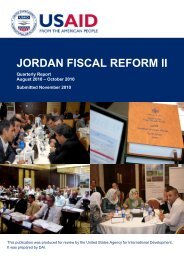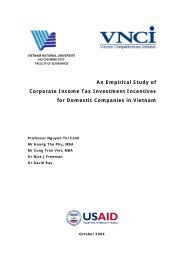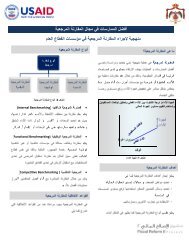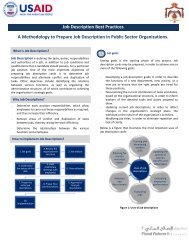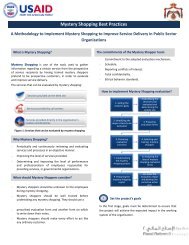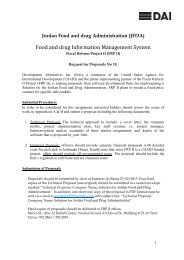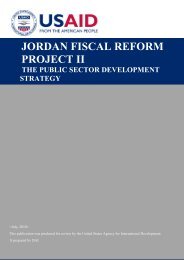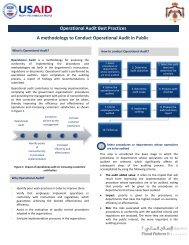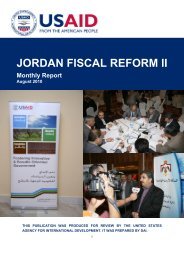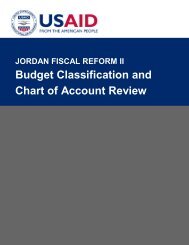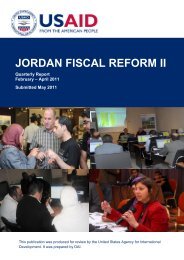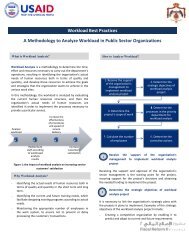Integrated Financial Management Information Systems: A ... - Frp2.org
Integrated Financial Management Information Systems: A ... - Frp2.org
Integrated Financial Management Information Systems: A ... - Frp2.org
You also want an ePaper? Increase the reach of your titles
YUMPU automatically turns print PDFs into web optimized ePapers that Google loves.
EXECUTIVE SUMMARY<br />
This paper discusses the subject of “best practices” for designing and implementing <strong>Integrated</strong><br />
<strong>Financial</strong> <strong>Management</strong> <strong>Information</strong> <strong>Systems</strong> (IFMIS) and how to put them into place in specific<br />
environments: namely, in developing and transitional countries as well as in conflict and post-conflict<br />
situations. The IFMIS provides a critical financial management solution for countries whose<br />
administrative and economic infrastructure is obsolete, or has been destroyed through war and years<br />
of conflict.<br />
There is broad agreement that a fully functioning IFMIS can improve governance by providing realtime<br />
financial information that financial and other managers can use to administer programs<br />
effectively, formulate budgets, and manage resources. Sound IFMIS systems, coupled with the<br />
adoption of centralized treasury operations, can not only help developing country governments gain<br />
effective control over their finances, but also enhance transparency and accountability, reducing<br />
political discretion and acting as a deterrent to corruption and fraud.<br />
Obstacles should not be underestimated. The road to implementing successful IFMIS in developing<br />
countries is paved with difficulties, such as resistance from the bureaucracies involved; lack of<br />
decision-making from the top; weak human capital; corruption and fraud; and, in the case of conflictridden<br />
countries, the instability and violence that impair any efficient long-term work. Moreover,<br />
IFMIS systems are complicated, expensive, and difficult to manage and maintain. Indeed, a 2003<br />
review of 34 IFMIS projects supported by the World Bank over 15 years estimated that only 6<br />
percent of the systems were likely to be sustained after donor support ceased.<br />
Obstacles notwithstanding, the task is still feasible. The technology exists and aid agencies can play a<br />
very important role in helping the decision-makers choose the most adaptable and appropriate tools<br />
for their environments. The choice of a step-by-step, or phased approach offers the best chances for<br />
successful implementation as a project can be carefully monitored and reviewed regularly. Given the<br />
cost of such exercises, it is important to aim first for a sound “entry level” system, which, once<br />
functioning effectively, can then be extended to support additional functions. Indeed, the simple<br />
demonstration effect of effective entry-level systems can generate the necessary demand for more<br />
comprehensive systems.<br />
Political will is crucial to this process. Once the decision has been made to implement an IFMIS, the<br />
battle is half won. Garnering support from those who will use the new system, and overcoming<br />
resistance from those who stand to lose from its implementation, can be an equally daunting<br />
challenge. Change management is therefore an important part of any IFMIS project.<br />
On a more practical level, selecting the right tools, equipment and technology requires a good deal of<br />
shopping around. All too often, it is discovered only after procurement of new systems that those<br />
systems do not meet the specific conditions and needs of the project, leading to costly delays and<br />
unplanned outlays. To avoid these types of hiccups, a variety of experts should be called on to test,<br />
monitor and guide the implementation process.<br />
Above all, IFMIS implementation requires patience. The full project life cycle—from definition of<br />
objectives, to system specifications, to system procurement, configuration, testing, and rollout—can<br />
easily take seven to ten years, or longer, to complete. This type of time horizon is usually well beyond<br />
the attention span of donors, which is why it is advisable to divide IFMIS implementation into clearly<br />
defined stages with clear objectives and milestones. As each stage is completed, stakeholders should<br />
carefully assess project progress and ensure that the system under development still meets the needs<br />
of the government, and that government commitment to the IFMIS is still there. The ultimate goal<br />
should be to put in place sound systems that are well understood and embraced by counterparts and in<br />
the end will be self-sustaining.<br />
EXECUTIVE SUMMARY IX



